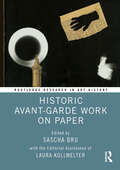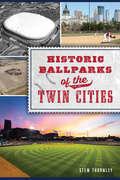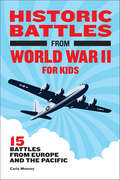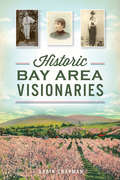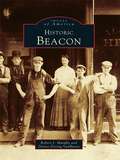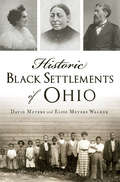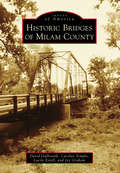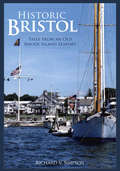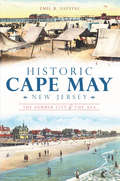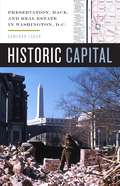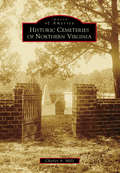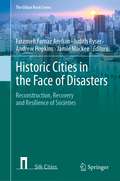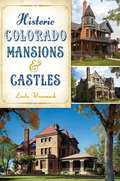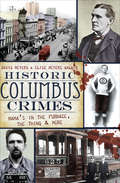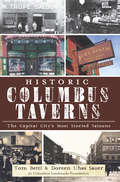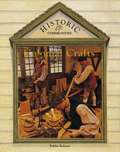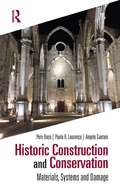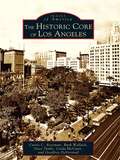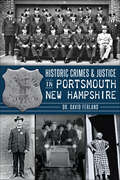- Table View
- List View
Historic Amusement Parks of Long Island: 118 Miles of Memories
by Marisa L. BermanWhen Long Island became a suburban paradise after World War II, ambitious entrepreneurs created dozens of amusement parks to help families unwind. The Nunley family built a park in Baldwin in 1939, and it was so successful that they opened Nunley's Happyland in Bethpage just a few years later. Westbury's Spaceland fascinated youngsters with dreams of becoming astronauts, and Frontier City in Amityville was heaven on earth to fans of the Wild West. Today, historic parks like Deno's Wonder Wheel Park in Coney Island and Adventureland in Farmingdale still delight children and remind parents of happy memories of their own. Local author Marisa Berman explores the decades of fun and laughter from Long Island's historic amusement parks.
Historic Austin Restaurants: Capital Cuisine through the Generations (American Palate)
by Melanie HauptAustin has staked its claim as the seat of innovative culinary movements, and its food culture mirrors the transformations taking place across the city. The evolution of the east side is reflected in joints like Franklin Barbecue, while landmarks like Scholz Garten, the oldest restaurant in the capital, testify to the contributions of the town's college presence and a healthy German influence. Joe's Bakery isn't just one of the town's most beloved Tex-Mex spots; it's the place where the real wheeling and dealing in Texas politics happens. Food writer Melanie Haupt samples Austin's iconic restaurants and the rich heritage that produced them.
Historic Avant-Garde Work on Paper (Routledge Research in Art History)
by Sascha Bru Laura KollwelterThis book examines the many functions of paper in the fine art and aesthetics of the early twentieth-century modernist or historic avant-garde (Expressionism, Cubism, Futurism, Dadaism, Surrealism, Constructivism and many more).With its many collages and photomontages, the historic avant-garde is generally considered to have transformed paper from a mere support into an artistic medium and to have assisted in art on paper gaining a firm autonomy. Bringing together an international team of scholars, this book shows that the story of paper in the avant-garde has thereby hardly been told. The first section looks at a selection of canonized individual avant-gardists’ work on paper to demonstrate that the material and formal analysis of paper in the avant-garde’s artistic production still holds much in store. In the second section, chapters zoom in on forms and formats of collective artistic production that deployed paper to move around reproductions of fine art works, to facilitate the dialogue between avant-gardists, to better promote their work among patrons, and to make their work available to a wider audience. Chapters in the third section lay bare how certain groups within the avant-garde began to massively create monochrome works, because these could be easily reproduced when transferred to, or reproduced as, linocuts. In the last section of the book, chapters explore how the avant-garde’s attentiveness to paper almost always also implied a critique of the ways in which paper, and all that it stood for, was treated and labored in European culture and society more broadly.The book will be of interest to scholars working in art history, modernism, and design.
Historic Ballparks of the Twin Cities (Sports)
by Stew ThornleyFrom the rickety to the palatial, ballparks have grown up with and defined baseball in Minneapolis and St. Paul. Some old-timers have vivid memories of cheering for Willie Mays and Roy Campanella at Nicollet and Lexington. Others marveled at a majestic Killebrew home run at the Met. Many a lucky resident celebrated two world championships in the Metrodome and witnessed one of the greatest pitching performances in World Series history. More recently, fans have enjoyed the return of sunshine and even raindrops at Target Field. Described by City Pages as "the most respected local baseball historian," Stew Thornley leads a tour of where we--as well as our grandparents and now our children--discovered baseball.
Historic Battles from World War II for Kids: 15 Battles from Europe and the Pacific (Historic Battles for Kids)
by Carla MooneyAn up-close look at the battles of World War II for kids ages 8 to 12Help kids learn all about World War II—right from the front lines. This fascinating guide focuses on the battles that decided the outcome of the war. Each entry puts kids directly in the general's seat, walking them through the flow of battle as well as the strategies, tactics, and technology that made the difference between victory and defeat.Go beyond other World War 2 books for kids with:15 key conflicts—Kids will dive deep into well-known and lesser-explored battles alike, from the Attack on Pearl Harbor to the Battle of Crete.Battlefield basics—Each chapter starts off a quick breakdown of the battle, including dates, objectives, and what was at stake.Closer looks—Young learners will find out even more with the help of technological explorations, battle maps, by-the-numbers sidebars, and more.Give kids an exciting new perspective on World War 2 history!
Historic Bay Area Visionaries (American Chronicles)
by Robin ChapmanFor centuries, California's environment has nurtured remarkable people. Ohlone Lope Inigo found a way to protect his family in troubled times on the shores of San Francisco Bay. Pioneer Juana Briones made a fortune from her rancho yet took the time to care for those in need. Innovator Thomas Foon Chew discovered a climate for success, in spite of the obstacles. Around the region that became Silicon Valley, filmmaker Charlie Chaplin found inspiration, poet Robert Louis Stevenson uncovered adventure and Sarah Winchester built a house that would intrigue people long after she was gone. Author Robin Chapman shares fascinating tales of those who exemplify the enterprising spirit of the Golden State.
Historic Beacon (Images of America)
by Denise Doring Vanburen Robert J. MurphyResidents of Beacon, New York, are justifiably proud of a community that is rich in history and promise. In this exquisite collection of images, local historians Robert J. Murphy and Denise Doring VanBuren uncover the fascinating past of Beacon andthe people who have called it home. The community's earliest permanent European settler was Madam Catheryna Rombout Brett, whose c. 1709 home is preserved within the city as the the oldest building in Dutchess County. Within the vicinity of the Madam Brett Homestead, two distinct villages grew: Matteawan, a manufacturing community at the foot of the mountain, and Fishkill Landing, a Hudson River port. Both villages prospered and eventually merged in 1913. Through the decades, the community was hailed as a model of a successful manufacturing center and became the location for several significant Hudson River estates. It played host to one of the longestrunning ferries in American history and introduced one of the first electric streetcar systems in the Hudson River Valley. Perhaps its most well-known feature was the Mount Beacon Incline Railway, a feat of engineering documented as the world's steepest incline railroad.
Historic Black Neighborhoods of Raleigh (American Heritage)
by Carmen Wimberley CauthenThe story of Raleigh's African American communities begins before the Civil War.Towns like Oberlin Village were built by free people of color in the antebellum era. During Reconstruction, the creation of thirteen freedmen's villages defined the racial boundaries of Raleigh. These neighborhoods demonstrate the determination and resilience of formerly enslaved North Carolinians. After World War II, new suburbs sprang up, telling tales of the growth and struggles of the Black community under Jim Crow. Many of these communities endure today. Dozens of never before published pictures and maps illustrate this hidden history.Local historian Carmen Wimberly Cauthen tells the story of a people who--despite slavery--wanted to learn, grow, and be treated as any others.
Historic Black Settlements of Ohio
by David Meyers Elise Meyers WalkerIn the years leading up to the Civil War, Ohio had more African American settlements than any other state. Owing to a common border with several slave states, it became a destination for people of color seeking to separate themselves from slavery. Despite these communities having populations that sometimes numbered in the hundreds, little is known about most of them, and by the beginning of the twentieth century, nearly all had lost their ethnic identities as the original settlers died off and their descendants moved away. Save for scattered cemeteries and an occasional house or church, they have all but been erased from Ohio's landscape. Father-daughter coauthors David Meyers and Elise Meyers Walker piece together the stories of more than forty of these black settlements.
Historic Bridges of Milam County (Images of America)
by Lucile Estell Carolyn Temple David Galbreath Joy GrahamMilam County, located in the heart of Central Texas, is home to 18 historic bridges that were constructed through the years to accommodate the growth of the county. One bridge, Worley Bridge, has been fully restored in a cooperative effort between Milam County and the Texas Department of Transportation (TXDOT). TXDOT is an important partner in the preservation of these historic structures. Memories of some bridges will be preserved in a bridge park, which is being constructed in Rockdale. Other bridges simply stand in mute testimony to the passing of time and the changing of human needs and habits. This book tells the story of these bridges and their important role in our history. It provides knowledge and understanding of these structures.
Historic Bristol: Tales from an Old Rhode Island Seaport
by Richard V. SimpsonAuthor Richard V. Simpson (who also penned Herreshoff Yachts) offers up a diverse sampling of fascinating and entertaining stories that explore Bristol's every facet from early investigations into possible Viking settlements on the peninsula to the nationally famous Fourth of July celebration, and from the antics of local politicians to the yachts and sailors that have brought the town glory and renown.
Historic Cape May, New Jersey: The Summer City by the Sea
by Emil R. SalviniCape May began as Cape May Island, where families journeyed to enjoy wide white beaches and gentle surf during the early nineteenth century. With the advent of steamships and railroads, the quiet village soon became America's first seaside resort town. Despite its charm and elegance, visitors slowed in the 1880s, as a series of mysterious fires claimed some of its most beloved structures. As the twentieth century dawned, Cape May's failure to modernize ultimately became its salvation. By the 1960s, visitors were once again flocking to this seaside destination to enjoy its quaint Victorian charm. Experience the elegant Chalfonte Hotel, stately Congress Hall and the classic Cape May Boardwalk with local historian Emil Salvini.
Historic Capital: Preservation, Race, and Real Estate in Washington, D.C.
by Cameron LoganWashington, D.C. has long been known as a frustrating and sometimes confusing city for its residents to call home. The monumental core of federal office buildings, museums, and the National Mall dominates the city&’s surrounding neighborhoods and urban fabric. For much of the postwar era, Washingtonians battled to make the city their own, fighting the federal government over the basic question of home rule, the right of the city&’s residents to govern their local affairs. In Historic Capital, urban historian Cameron Logan examines how the historic preservation movement played an integral role in Washingtonians&’ claiming the city as their own. Going back to the earliest days of the local historic preservation movement in the 1920s, Logan shows how Washington, D.C.&’s historic buildings and neighborhoods have been a site of contestation between local interests and the expansion of the federal government&’s footprint. He carefully analyzes the long history of fights over the right to name and define historic districts in Georgetown, Dupont Circle, and Capitol Hill and documents a series of high-profile conflicts surrounding the fate of Lafayette Square, Rhodes Tavern, and Capitol Park, SW before discussing D.C. today.Diving deep into the racial fault lines of D.C., Historic Capital also explores how the historic preservation movement affected poor and African American residents in Anacostia and the U Street and Shaw neighborhoods and changed the social and cultural fabric of the nation&’s capital. Broadening his inquiry to the United States as a whole, Logan ultimately makes the provocative and compelling case that historic preservation has had as great an impact on the physical fabric of U.S. cities as any other private or public sector initiative in the twentieth century.
Historic Cemeteries of Houston and Galveston (Landmarks)
by Tristan SmithAuthor Tristan Smith offers an insightful guide through two dozen of Houston and Galveston's most historic cemeteries. Houston and Galveston's historic cemeteries lie scattered amongst the neighborhoods and thoroughfares of the nation's fourth largest city. Some of these portals to the past nestle in hidden pockets of the bustling metropolis. Other cemeteries carve out the kind of contemplative sanctuary that rivals the city's largest greenspaces. Explore the burial grounds around the Bayou City, where astronauts, musicians, movie stars and civic leaders rest alongside rogues, scoundrels and murderers.
Historic Cemeteries of Long Beach (Images of America)
by Gerrie SchipskeThe stories of those who lived in the city by the sea begin long before the 1878 date on the oldest headstone found in the city. Long Beach was the site of ceremonies, and perhaps the burial grounds, for the Tongva tribe. Many of those who later settled the city are buried in one of the four known cemeteries, Municipal, Sunnyside, Forest Lawn Long Beach, and All Souls. Two of the cemeteries hold the graves of several hundred Union and Confederate Civil War veterans, one Medal of Honor recipient, and a slave who served in the 1st Colored Heavy Artillery Regiment. The histories of the Municipal and Sunnyside Cemeteries include the 1921 discovery of oil, which made national news as descendants of the deceased fought for the oil underneath the graves. The fight resulted in a second Sunnyside Cemetery that later became Forest Lawn Long Beach. The scene of oil derricks surrounding the cemeteries was so surreal that it caught the attention of Ansel Adams, whose photographs of Sunnyside Cemetery are included.
Historic Cemeteries of Northern Virginia
by Charles A. MillsNorthern Virginia's cemeteries are time capsules reflecting the region's 350 years of history. They offer a glimpse into the lives and fortunes of the famous, the infamous, and those who are remembered for loving their families, tending to their business, and quietly supporting their communities. There are some 1,000 cemeteries in Northern Virginia, ranging from small family plots to huge national cemeteries covering hundreds of acres. This book presents the history of the region through the medium of cemeteries. Every gravestone has a story to tell. Confederate raiders, freedmen, eccentrics, and nation builders lived and died in Northern Virginia. Sometimes, tombstones are all that remain of their stories. Often, finding their tombstones is the first step in rediscovering the stories of these figures.
Historic Cities in the Face of Disasters: Reconstruction, Recovery and Resilience of Societies (The Urban Book Series)
by Fatemeh Farnaz Arefian Andrew Hopkins Judith Ryser Jamie MackeeThis book examines reconstruction and resilience of historic cities and societies from multiple disciplinary and complementary perspectives and, by doing so, it helps researchers and practitioners alike, among them reconstruction managers, urban governance and professionals. The book builds on carefully selected and updated papers accepted for the 2019 Silk Cities international conference on ‘reconstruction, recovery and resilience of historic cities and societies’, the third Silk Cities conference held in L’Aquila, Italy, 10-12 July 2019, working with University of L’Aquila and UCL.This multi-scale, and multidisciplinary book offers cross-sectoral and complimentary voices from multiple stakeholders, including academia, urban governance, NGOs and local populations. It examines post-disaster reconstruction strategies and case studies from Europe, Asia and Latin America that provide a valuable collection for anyone who would like to get a global overview on the subject matter. It thereby enables a deeper understanding of challenges, opportunities and approaches in dealing with historic cities facing disasters at various geographical scales. Additionally, it brings together historical approaches to the reconstruction of historical cities and those of more recent times. Thus, it can be used as a reference book for global understanding of the subject matter.
Historic Colorado Mansions & Castles (Landmarks)
by Linda WommackThe discovery of gold and silver in Colorado's Rocky Mountains minted millionaires by the ton. The rough settlements of miners and ranchers quickly transformed into habitations more suitable for the newly wealthy class. William Newton Byers founded the Centennial State's first newspaper and built an Italianate-style palace with the proceeds, while Walter Scott Cheesman's Capitol Hill home later became the governor's residence. Stroll into the parlors and drawing rooms of oligarchs like August A. Meyer, Lyman Robison and James Joseph Brown. Visit Romanesque castles cut from native lava and country retreats designed by the country's foremost architects. Linda Wommack offers a tour of the finest mansions in Colorado, all proudly bearing the mark of the State and National Registers of Historic Preservation.
Historic Colorado: Day Trips & Weekend Getaways to Historic Towns, Cities, Sites & Wonders
by Claude WiatrowskiWith its ancient pueblos and dinosaur bones, its gold mines and railroads, and its pioneering place in the westward push of the American frontier, Colorado is a state alive with history. This illustrated adventure through historical Colorado takes readers by scenic backroads from the towering Rocky Mountains to the vast Great Plains, with stops at every turn for a revealing view of the state’s rich past. Filled with spectacular modern photographs and historic black-and-white images, Historic Colorado tells the stories behind the most important and fascinating places in the growth and character of the Centennial State. The book follows in the footsteps of explorers and prospectors, cowpokes and pioneers, down the Santa Fe Trail, across the Continental Divide, up Clear Creek, and over Lizard Head Pass. It explores the legacy of mining, the railroads, and the Old West, as well as the heritage of Native Americans. It ventures through towns and cities, farmland and untamed wilderness, revisiting the stories of the people and personalities who made centuries of history in America's highest state. Maps and travel tips round out the book, making it as useful to the tourist as it is entertaining for the armchair traveler.
Historic Columbus Crimes: Mama's in the Furnace, the Thing & More (Murder And Mayhem Ser.)
by David Meyers Elise Meyers WalkerA collection of true crime stories from the Ohio city, with photos included. In Historic Columbus Crimes, a father-daughter research team looks back at sixteen tales of murder, mystery, and mayhem culled from city history, both the distant and the more recent past. There&’s the rock star slain by a troubled fan; the drag queen slashed to death by a would-be ninja; the writer who died acting out the plot of his next book; the minister&’s wife incinerated in the parsonage furnace; and a couple of serial killers who outdid the Son of Sam. Also covered are a gunfight at Broad and High, grave-robbing medical students, and the bloodiest day in FBI history. Includes photos and illustrations
Historic Columbus Taverns: The Capital City's Most Storied Saloons
by Tom Betti Doreen Uhas SauerOne of the first buildings in Central Ohio in the 1790s was a tavern and 200 years later--Columbus as a "foodie" town shows renewed interest in discovering its historic "liquid assets." Once historic taverns in frontier Columbus featured live bears chained to giant wheels, pumping water for travelers in need of a shower and giving new meaning to the term "watering hole." Existing historic taverns in Columbus span from 1830s through the 1930s and still have little-known histories, stories, scandals, as well as, architectural fabric to explore. One is built on a still active graveyard; another is in the building of a former Pentecostal church. Several remain from the Irish and German migrations and survived Prohibition; one was the quintessential gentlemen's bar still with pool room that connected by underground tunnel to the Ohio Statehouse in a time of temperance. Another was both a tavern and a bordello for Union and Confederate officers (though on different nights). Set in the social and political historic context of a changing city, the taverns offer a chance to explore the city's history through its watering holes.
Historic Communities: Colonial Crafts
by Bobbie KalmanChildren will have fun learning about: -- early homes and the settler community-- what people wore and the crafts they made-- how settlers made their living-- how they spent their leisure time-- the values, customs, and traditions of the early settlers Colonial Crafts introduces young readers to the craftspeople who created useful works of art by hand, many of which have lasted more than two hundred years. Children will find out how the artisans learned their trades through many years of apprenticeship, as their masters did before them.
Historic Construction and Conservation: Materials, Systems and Damage
by Pere Roca Paulo B. Lourenço Angelo GaetaniConservation in the built environment raises fundamental questions which have been debated for centuries - what is worth preserving, how is it possible, why is it important? This book takes a modern approach to the meaning of a heritage structure and its conservation. The historical evolution of conservation is briefly addressed, considering prominent individuals and cases; along with the history of construction, focusing on materials and related structural elements, with insight on the sizing rules adopted by masons. This explains structural decisions made during the construction process and allows comparison of scientific theories from the 18th century to modern understanding of limit analysis. Damage and collapse mechanisms for masonry construction, as the most widespread structural form for historical buildings, is described. Excess permanent loading and settlement is differentiated from environmental and anthropogenic actions such as earthquake or incorrect intervention. The team of authors brings together unique expertise, with high level research and leading practice with archetypical cases from around the world. The book addresses the history of conservation by exploring materials and structures and the history of construction and damage, so it is of value to students and professionals in civil engineering and architecture, as well as archaeologists and art historians.
Historic Core of Los Angeles, The
by Linda Mccann Curtis C. Roseman Dace Taube Ruth WallachIn the early 20th century, there was no better example of a classic American downtown than Los Angeles. Since World War II, Los Angeles's Historic Core has been "passively preserved," with most of its historic buildings left intact. Recent renovations of the area for residential use and the construction of Disney Hall and the Staples Center are shining a new spotlight on its many pre-1930s Beaux Arts, Art Deco, and Spanish Baroque buildings.
Historic Crimes & Justice in Portsmouth, New Hampshire (True Crime)
by Dr. David FerlandThe first courts handled crimes like lying, idleness and card playing with punishments that ranged from fines to public whipping to death by hanging. Constables kept order until Portsmouth's first police officer took up the shield in 1800. But no force could keep all crime at bay. The court sentenced the beautiful, educated Ruth Blay to hanging on shaky evidence that she might have killed her baby. Business magnate Frank Jones played corrupt politics, succumbed to extramarital temptations and helped make Water Street the red-lighted rum hole destination of the eastern seaboard. Mischievous sailors came into port looking to spend their money, finding ample opportunity in Portsmouth's bowery bordellos. Retired Portsmouth police officer David "Lou" Ferland traces the history of Portsmouth crime and justice from the first courts to today's award-winning police department.


